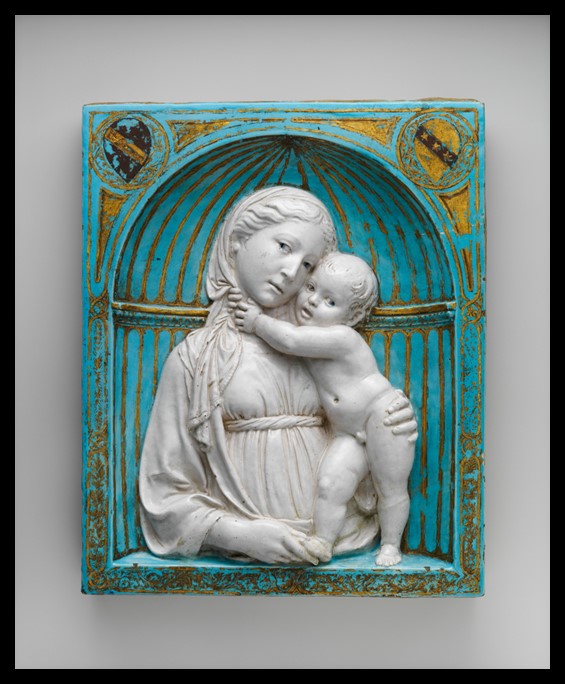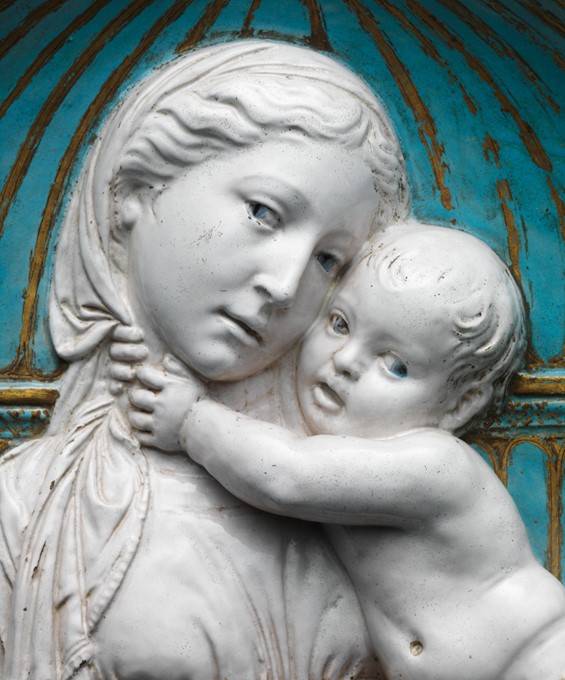
Virgin and Child in a niche, ca. 1460, Glazed terracotta with gilt and painted details, 47.3 × 38.7 × 8.9 cm, 13.2 kg, the MET, NY, USA
https://www.metmuseum.org/art/collection/search/204722
…It then occurred to Luca della Robia that clay can be manipulated with ease and little trouble, and that the only thing required was to discover a means whereby work produced in this material could be preserved a long time. By dint of many experiments he discovered a method of protecting it from the injury of time, for he found that he could render such works practically imperishable, by covering the clay with a glaze made of tin, litharge, antimony and other materials, baked in the fire in a specially constructed furnace. For this method, of which he was the inventor, he won loud praises, and all succeeding ages are under an obligation to him… The MET Bliss Madonna by Luca della Robbia is one such fine example of his skillful use of clay and a tin glaze! https://www.artist-biography.info/artist/luca_della_robbia/ Giorgio Vasari, Lives of the Most Excellent Painters, Sculptors, and Architects, first published in 1550 and dedicated to Grand Duke Cosimo I de’ Medici
Luca della Robbia (1399/1400–1482) was an Italian sculptor and ceramist renowned for his contributions to the Renaissance artistic movement. Born in Florence, he hailed from a family of artists and began his career as a sculptor. However, Luca is best known for perfecting the technique of glazed terracotta sculpture, a medium he elevated to new heights. His innovative use of vibrant polychrome glazes brought a lifelike quality to his works, distinguishing him from his contemporaries. His artistry, marked by a harmonious blend of classical influences and innovative techniques, left an enduring legacy and influenced later generations of artists.
The artist was an innovator. Before him, sculptors primarily worked with marble or bronze, and clay was mostly used for preparatory models rather than finished works of art. Luca’s innovation was to take terracotta, a material that had been traditionally associated with architectural decoration, and elevate it to the status of a refined artistic medium. His breakthrough was the development of a tin glaze that, when applied to terracotta, created a smooth, lustrous surface. This glazing technique not only added a layer of protection to the sculptures but also allowed for the application of vibrant and enduring polychrome colors. This marked a departure from the monochromatic nature of traditional terracotta works.
Luca’s creations, ranging from religious reliefs to freestanding sculptures, were characterized by a newfound vibrancy and a lifelike quality. This innovation made his sculptures more accessible to a broader audience and contributed to the democratization of art during the Renaissance. He even began a practice of reproducing his clay sculptures in casts, which members of his family and large workshop continued into the sixteenth century. His influence extended beyond his family workshop, inspiring other artists to explore the potential of terracotta and glazing techniques, thus contributing to the dynamic and transformative period of artistic flourishing in Renaissance Florence. https://www.metmuseum.org/art/collection/search/204722
The artwork of the day is the Bliss Madonna by Luca della Robbia in the Metropolitan Museum of Art in New York City.

Virgin and Child in a niche (detail), ca. 1460, Glazed terracotta with gilt and painted details, 47.3 × 38.7 × 8.9 cm, 13.2 kg, the MET, NY, USA
https://www.metmuseum.org/art/collection/search/204722
A classic masterpiece by Luca della Robbia, the Bliss Madonna captivates the viewer’s attention with its serene beauty and religious devotion. In front of a niche defined by gilded ribs against a lively turquoise backdrop, the Virgin Mary is depicted tenderly cradling the infant Jesus, who stands at the niche’s edge, leans towards her, and equally tenderly embraces her. The intimate connection is palpable as Christ reaches around her neck, and their heads gently touch, revealing blue-gray eyes that engage the viewer. The composition’s frame is adorned with an intricate floral design, and the upper corners proudly bear the Bartorelli and Baldi coats of arms, symbolizing a probable union between these prominent Florentine families.
Luca della Robbia’s terracotta sculptures of the Madonna with the Child, like the MET’s Bliss Madonna, represent a high point of Renaissance sculpture, showcasing the artist’s innovative approach to the medium. The application of polychrome glazes, like the turquoise in the discussed artifact, allowed him to achieve a luminous, almost ethereal quality in his artworks. The delicate expressions on the faces of the Madonna and Child, coupled with the intricacies of drapery and the overall harmonious composition, reflect della Robbia’s deep understanding of both classical ideals and the spiritual essence he sought to convey. These amazing, glazed terracotta sculptures became iconic representations of religious devotion during the Renaissance and contributed to the broader artistic movement’s exploration of new materials and techniques.
For a PowerPoint depicting 10 Masterpieces by Luca della Robbia, please… Check HERE!